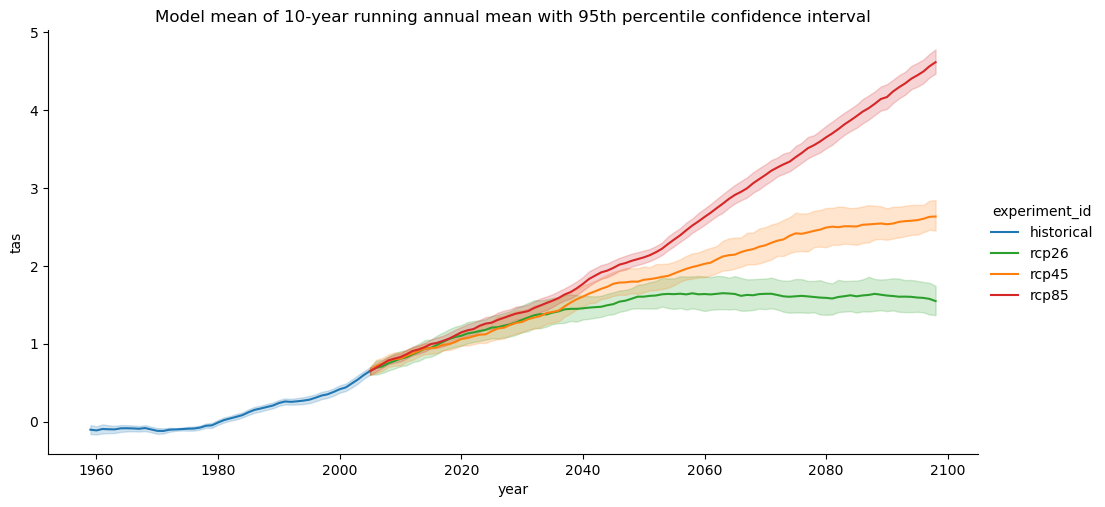AWS Access#
A growing number of CORDEX datasets is now available from AWS S3. In this examples, we will show how to access the datasets using an ESM collection and derive an ensemble mean.
from dask.distributed import Client
client = Client()
client
Client
Client-4a5976e3-0183-11ee-928a-080038c05de1
| Connection method: Cluster object | Cluster type: distributed.LocalCluster |
| Dashboard: /user/g300046/levante-spawner-preset//proxy/8787/status |
Cluster Info
LocalCluster
7ecd69b9
| Dashboard: /user/g300046/levante-spawner-preset//proxy/8787/status | Workers: 16 |
| Total threads: 256 | Total memory: 235.37 GiB |
| Status: running | Using processes: True |
Scheduler Info
Scheduler
Scheduler-e64ea2c3-858b-4233-b61d-b2ef8fc7afd7
| Comm: tcp://127.0.0.1:41235 | Workers: 16 |
| Dashboard: /user/g300046/levante-spawner-preset//proxy/8787/status | Total threads: 256 |
| Started: Just now | Total memory: 235.37 GiB |
Workers
Worker: 0
| Comm: tcp://127.0.0.1:41111 | Total threads: 16 |
| Dashboard: /user/g300046/levante-spawner-preset//proxy/40821/status | Memory: 14.71 GiB |
| Nanny: tcp://127.0.0.1:41607 | |
| Local directory: /tmp/dask-worker-space/worker-v1esnpac | |
Worker: 1
| Comm: tcp://127.0.0.1:34879 | Total threads: 16 |
| Dashboard: /user/g300046/levante-spawner-preset//proxy/40627/status | Memory: 14.71 GiB |
| Nanny: tcp://127.0.0.1:44137 | |
| Local directory: /tmp/dask-worker-space/worker-lh7bbaap | |
Worker: 2
| Comm: tcp://127.0.0.1:35503 | Total threads: 16 |
| Dashboard: /user/g300046/levante-spawner-preset//proxy/40555/status | Memory: 14.71 GiB |
| Nanny: tcp://127.0.0.1:43701 | |
| Local directory: /tmp/dask-worker-space/worker-wif0l4jq | |
Worker: 3
| Comm: tcp://127.0.0.1:41101 | Total threads: 16 |
| Dashboard: /user/g300046/levante-spawner-preset//proxy/36503/status | Memory: 14.71 GiB |
| Nanny: tcp://127.0.0.1:32907 | |
| Local directory: /tmp/dask-worker-space/worker-wl_1xidi | |
Worker: 4
| Comm: tcp://127.0.0.1:43465 | Total threads: 16 |
| Dashboard: /user/g300046/levante-spawner-preset//proxy/45937/status | Memory: 14.71 GiB |
| Nanny: tcp://127.0.0.1:35365 | |
| Local directory: /tmp/dask-worker-space/worker-dveyg8kd | |
Worker: 5
| Comm: tcp://127.0.0.1:36237 | Total threads: 16 |
| Dashboard: /user/g300046/levante-spawner-preset//proxy/42605/status | Memory: 14.71 GiB |
| Nanny: tcp://127.0.0.1:41307 | |
| Local directory: /tmp/dask-worker-space/worker-_y_vz218 | |
Worker: 6
| Comm: tcp://127.0.0.1:37013 | Total threads: 16 |
| Dashboard: /user/g300046/levante-spawner-preset//proxy/42733/status | Memory: 14.71 GiB |
| Nanny: tcp://127.0.0.1:43859 | |
| Local directory: /tmp/dask-worker-space/worker-sccalkde | |
Worker: 7
| Comm: tcp://127.0.0.1:35859 | Total threads: 16 |
| Dashboard: /user/g300046/levante-spawner-preset//proxy/46553/status | Memory: 14.71 GiB |
| Nanny: tcp://127.0.0.1:41239 | |
| Local directory: /tmp/dask-worker-space/worker-0cj6j8x4 | |
Worker: 8
| Comm: tcp://127.0.0.1:46347 | Total threads: 16 |
| Dashboard: /user/g300046/levante-spawner-preset//proxy/37095/status | Memory: 14.71 GiB |
| Nanny: tcp://127.0.0.1:37803 | |
| Local directory: /tmp/dask-worker-space/worker-jlbaa02h | |
Worker: 9
| Comm: tcp://127.0.0.1:44733 | Total threads: 16 |
| Dashboard: /user/g300046/levante-spawner-preset//proxy/38879/status | Memory: 14.71 GiB |
| Nanny: tcp://127.0.0.1:45875 | |
| Local directory: /tmp/dask-worker-space/worker-5pzvcfje | |
Worker: 10
| Comm: tcp://127.0.0.1:35087 | Total threads: 16 |
| Dashboard: /user/g300046/levante-spawner-preset//proxy/34231/status | Memory: 14.71 GiB |
| Nanny: tcp://127.0.0.1:41155 | |
| Local directory: /tmp/dask-worker-space/worker-s253ymsv | |
Worker: 11
| Comm: tcp://127.0.0.1:37085 | Total threads: 16 |
| Dashboard: /user/g300046/levante-spawner-preset//proxy/46787/status | Memory: 14.71 GiB |
| Nanny: tcp://127.0.0.1:37071 | |
| Local directory: /tmp/dask-worker-space/worker-5ezpfj6d | |
Worker: 12
| Comm: tcp://127.0.0.1:36379 | Total threads: 16 |
| Dashboard: /user/g300046/levante-spawner-preset//proxy/32953/status | Memory: 14.71 GiB |
| Nanny: tcp://127.0.0.1:46357 | |
| Local directory: /tmp/dask-worker-space/worker-bge43y6d | |
Worker: 13
| Comm: tcp://127.0.0.1:35509 | Total threads: 16 |
| Dashboard: /user/g300046/levante-spawner-preset//proxy/32787/status | Memory: 14.71 GiB |
| Nanny: tcp://127.0.0.1:32985 | |
| Local directory: /tmp/dask-worker-space/worker-cn0nf5ph | |
Worker: 14
| Comm: tcp://127.0.0.1:33263 | Total threads: 16 |
| Dashboard: /user/g300046/levante-spawner-preset//proxy/40853/status | Memory: 14.71 GiB |
| Nanny: tcp://127.0.0.1:35567 | |
| Local directory: /tmp/dask-worker-space/worker-7alydjej | |
Worker: 15
| Comm: tcp://127.0.0.1:36937 | Total threads: 16 |
| Dashboard: /user/g300046/levante-spawner-preset//proxy/43793/status | Memory: 14.71 GiB |
| Nanny: tcp://127.0.0.1:33845 | |
| Local directory: /tmp/dask-worker-space/worker-6qnxo7uk | |
import cf_xarray as cfxr
import fsspec
import intake
import xarray as xr
url = "https://euro-cordex.s3.eu-central-1.amazonaws.com/catalog/CORDEX-CMIP5.json"
cat = intake.open_esm_datastore(url)
cat
cordex-cmip5 catalog with 177 dataset(s) from 177 asset(s):
| unique | |
|---|---|
| project_id | 1 |
| product | 1 |
| CORDEX_domain | 1 |
| institute_id | 12 |
| driving_model_id | 10 |
| experiment_id | 5 |
| member | 4 |
| model_id | 13 |
| rcm_version_id | 4 |
| frequency | 1 |
| variable_id | 1 |
| version | 89 |
| path | 177 |
| derived_variable_id | 0 |
cat.df.head()
| project_id | product | CORDEX_domain | institute_id | driving_model_id | experiment_id | member | model_id | rcm_version_id | frequency | variable_id | version | path | |
|---|---|---|---|---|---|---|---|---|---|---|---|---|---|
| 0 | cordex | output | EUR-11 | CLMcom-ETH | MPI-M-MPI-ESM-LR | historical | r1i1p1 | COSMO-crCLIM-v1-1 | v1 | mon | tas | v20191219 | s3://euro-cordex/CMIP5/cordex/output/EUR-11/CL... |
| 1 | cordex | output | EUR-11 | SMHI | CNRM-CERFACS-CNRM-CM5 | historical | r1i1p1 | RCA4 | v1 | mon | tas | v20131026 | s3://euro-cordex/CMIP5/cordex/output/EUR-11/SM... |
| 2 | cordex | output | EUR-11 | CLMcom-ETH | CNRM-CERFACS-CNRM-CM5 | rcp85 | r1i1p1 | COSMO-crCLIM-v1-1 | v1 | mon | tas | v20210430 | s3://euro-cordex/CMIP5/cordex/output/EUR-11/CL... |
| 3 | cordex | output | EUR-11 | KNMI | ICHEC-EC-EARTH | historical | r3i1p1 | RACMO22E | v1 | mon | tas | v20190108 | s3://euro-cordex/CMIP5/cordex/output/EUR-11/KN... |
| 4 | cordex | output | EUR-11 | DMI | CNRM-CERFACS-CNRM-CM5 | rcp85 | r1i1p1 | HIRHAM5 | v2 | mon | tas | v20190208 | s3://euro-cordex/CMIP5/cordex/output/EUR-11/DM... |
We can open a single datasets from S3 by using the URL from data dataframe, e.g., to look at
cat.df.iloc[0]
project_id cordex
product output
CORDEX_domain EUR-11
institute_id CLMcom-ETH
driving_model_id MPI-M-MPI-ESM-LR
experiment_id historical
member r1i1p1
model_id COSMO-crCLIM-v1-1
rcm_version_id v1
frequency mon
variable_id tas
version v20191219
path s3://euro-cordex/CMIP5/cordex/output/EUR-11/CL...
Name: 0, dtype: object
we can open this dataset using xarray with zarr
ds = xr.open_zarr(
store=fsspec.get_mapper(cat.df.iloc[0].path, anon=True), consolidated=True
)
ds
<xarray.Dataset>
Dimensions: (rlat: 412, rlon: 424, time: 684, bnds: 2)
Coordinates:
height float64 ...
lat (rlat, rlon) float64 dask.array<chunksize=(412, 424), meta=np.ndarray>
lon (rlat, rlon) float64 dask.array<chunksize=(412, 424), meta=np.ndarray>
* rlat (rlat) float64 -23.38 -23.26 -23.16 ... 21.61 21.73 21.83
* rlon (rlon) float64 -28.38 -28.26 -28.16 ... 17.93 18.05 18.16
* time (time) datetime64[ns] 1949-01-16T12:00:00 ... 2005-12-16T12...
Dimensions without coordinates: bnds
Data variables:
rotated_pole |S1 ...
tas (time, rlat, rlon) float32 dask.array<chunksize=(143, 412, 424), meta=np.ndarray>
time_bnds (time, bnds) datetime64[ns] dask.array<chunksize=(143, 2), meta=np.ndarray>
Attributes: (12/26)
CORDEX_domain: EUR-11
Conventions: CF-1.4
c3s_disclaimer: This data has been produced in the contex...
comment: Please use the following reference for th...
config_cclm: EUR-11_CLMcom-ETH-COSMO-crCLIM-v1-1_01_co...
config_int2lm: EUR-11_int2lm2.5.1_01_config
... ...
project_id: CORDEX
rcm_version_id: v1
references: http://cordex.clm-community.eu/
source: Climate Limited-area Modelling Community ...
title: CLMcom-ETH-COSMO-crCLIM-v1-1 model output...
tracking_id: 151e60a4-e4c0-11e9-a214-d09466354597(ds.tas.isel(time=0) - 273.5).plot()
<matplotlib.collections.QuadMesh at 0x7ffe6dde79a0>
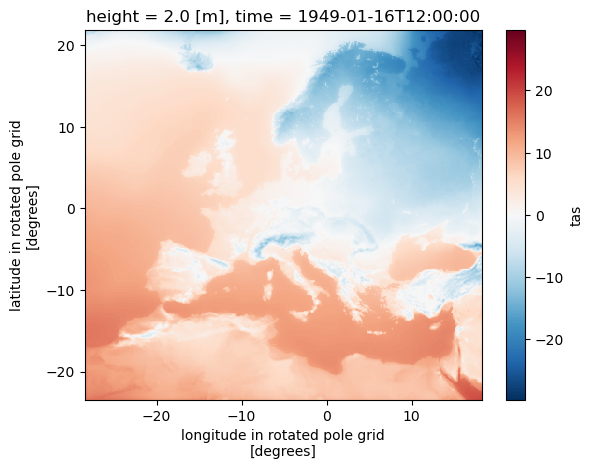
ds.close()
Open an ESM collection#
We can also use intake to open a collection of datasets into a dictionary. E.g., to open up all 2m temperature datasets, we search for them in the catalog:
subset = cat.search(
variable_id="tas", experiment_id=["historical", "rcp26", "rcp45", "rcp85"]
)
subset
cordex-cmip5 catalog with 165 dataset(s) from 165 asset(s):
| unique | |
|---|---|
| project_id | 1 |
| product | 1 |
| CORDEX_domain | 1 |
| institute_id | 11 |
| driving_model_id | 9 |
| experiment_id | 4 |
| member | 4 |
| model_id | 12 |
| rcm_version_id | 4 |
| frequency | 1 |
| variable_id | 1 |
| version | 84 |
| path | 165 |
| derived_variable_id | 0 |
dsets = subset.to_dataset_dict(
xarray_open_kwargs={"consolidated": True, "decode_times": True, "use_cftime": True},
storage_options={"anon": True},
)
--> The keys in the returned dictionary of datasets are constructed as follows:
'project_id.CORDEX_domain.institute_id.driving_model_id.experiment_id.member.model_id.rcm_version_id.frequency'
Let’s check the size of all datasets we just opened lazily!
size = sum([ds.nbytes for ds in dsets.values()])
print(f"Total size: {size/1.e9} GB")
Total size: 117.931165865 GB
There are different numbers of datsets for each scenario. For later computations, it’s useful to sort those datasets out. We will also combine scenario data with historical data so we can make a running mean easily.
from collections import OrderedDict, defaultdict
import tqdm
def sort_datasets(dsets):
"""sort datasets by scenario and append historical data"""
results = defaultdict(dict)
for dset_id, ds in tqdm.tqdm(dsets.items()):
exp_id = dset_id.split(".")[4]
new_id = dset_id.replace(f"{exp_id}.", "")
# collect historical
if exp_id == "historical":
results[exp_id][new_id] = ds
continue
# if scenario, look for corresponding historical data
# and concat if historical is available
hist_id = dset_id.replace(exp_id, "historical")
if hist_id not in dsets.keys():
print(f"historical not found: {hist_id}")
continue
# results[exp_id][new_id] = v
else:
results[exp_id][new_id] = xr.concat(
[dsets[hist_id][["tas"]], ds[["tas"]]], dim="time"
)
return results
def sort_datasets(dsets):
results = defaultdict(dict)
for dset_id, ds in tqdm.tqdm(dsets.items()):
exp_id = dset_id.split(".")[4]
new_id = dset_id.replace(f"{exp_id}.", "")
if exp_id != "historical":
ds = ds.sel(time=slice("2006", "2100"))
else:
ds = ds.sel(time=slice("1950", "2005"))
results[exp_id][new_id] = ds
return OrderedDict(sorted(results.items()))
dsets_sorted = sort_datasets(dsets)
100%|██████████| 165/165 [00:00<00:00, 464.92it/s]
dsets_sorted["historical"][
"cordex.EUR-11.CLMcom.ICHEC-EC-EARTH.r12i1p1.CCLM4-8-17.v1.mon"
]
<xarray.Dataset>
Dimensions: (rlat: 412, rlon: 424, vertices: 4, time: 672,
bnds: 2)
Coordinates:
height float64 ...
lat (rlat, rlon) float32 dask.array<chunksize=(412, 424), meta=np.ndarray>
lon (rlat, rlon) float32 dask.array<chunksize=(412, 424), meta=np.ndarray>
* rlat (rlat) float64 -23.38 -23.26 ... 21.73 21.83
* rlon (rlon) float64 -28.38 -28.26 ... 18.05 18.16
* time (time) object 1950-01-16 12:00:00 ... 2005-12...
Dimensions without coordinates: vertices, bnds
Data variables:
lat_vertices (rlat, rlon, vertices) float32 dask.array<chunksize=(412, 424, 4), meta=np.ndarray>
lon_vertices (rlat, rlon, vertices) float32 dask.array<chunksize=(412, 424, 4), meta=np.ndarray>
rotated_latitude_longitude int32 ...
tas (time, rlat, rlon) float32 dask.array<chunksize=(142, 412, 424), meta=np.ndarray>
time_bnds (time, bnds) object dask.array<chunksize=(142, 2), meta=np.ndarray>
Attributes: (12/45)
CORDEX_domain: EUR-11
Conventions: CF-1.4
cmor_version: 2.9.1
comment: CORDEX Europe RCM CCLM 0.11 deg EUR-11
contact: cordex-cclm@dkrz.de
creation_date: 2014-03-19T07:56:10Z
... ...
intake_esm_attrs:frequency: mon
intake_esm_attrs:variable_id: tas
intake_esm_attrs:version: v20140515
intake_esm_attrs:path: s3://euro-cordex/CMIP5/cordex/output/...
intake_esm_attrs:_data_format_: zarr
intake_esm_dataset_key: cordex.EUR-11.CLMcom.ICHEC-EC-EARTH.h...Let’s check out a yearly rolling mean of a single dataset:
dsets_sorted["rcp26"][
"cordex.EUR-11.CLMcom.ICHEC-EC-EARTH.r12i1p1.CCLM4-8-17.v1.mon"
].tas.groupby("time.year").mean().cf.mean(("X", "Y")).rolling(year=30).mean().plot()
[<matplotlib.lines.Line2D at 0x7ffabe552250>]
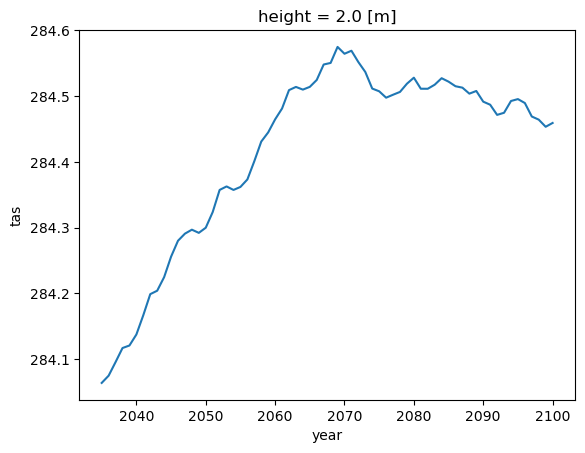
Investigate regional warming in the entire ensemble#
Let’s do it for the whole ensemble! We define a function to compute a simple yearly mean and a function that concatenates all yearly datasets into one ensemble dataset.
xr.set_options(keep_attrs=True)
def yearly_mean(ds):
"""compute yearly mean for one dataset"""
return ds.groupby("time.year").mean().cf.mean(("X", "Y"))
def ensemble_mean(dsets):
"""compute ensemble yearly mean"""
return xr.concat(
[yearly_mean(ds.tas) for ds in dsets.values()],
dim=xr.DataArray(list(dsets.keys()), dims="dset_id"),
coords="minimal",
compat="override",
)
Now, we can create a dictionary of ensemble means for each scenario. Here we ‘hit the compute button’ to store those results in memory. This can take some minutes since we reduce the spatical and temporal dimensions of the whole ensemble:
%time ensembles = {exp_id: ensemble_mean(dsets).compute() for exp_id, dsets in dsets_sorted.items()}
CPU times: user 1min 14s, sys: 4.83 s, total: 1min 19s
Wall time: 2min 15s
ensembles.keys()
dict_keys(['historical', 'rcp26', 'rcp45', 'rcp85'])
In the following step, we concatenate all scenario ensembles into one dataset with the scneario as a coordinate. That will make analysis and plotting much easier.
ensemble = xr.concat(
[ds.copy(deep=True) for ds in ensembles.values()],
dim=xr.DataArray(list(ensembles.keys()), dims="experiment_id"),
)
Let’s check again the size of our reduced dataset.
print(f"Total size: {ensemble.nbytes/1.e6} MB")
Total size: 0.152208 MB
This is for some datasets that actually have temperature data in degrees Celsius:
dset_id = ensemble.where(ensemble < 100.0, drop=True).dset_id
ensemble.loc[dict(dset_id=dset_id)] = ensemble.sel(dset_id=dset_id) + 273.5
Let’s check the data we got by plotting an overview for each scenario.
ensemble.plot(col="experiment_id", col_wrap=2, hue="dset_id", figsize=(20, 15))
<xarray.plot.facetgrid.FacetGrid at 0x7ffa1a759d60>
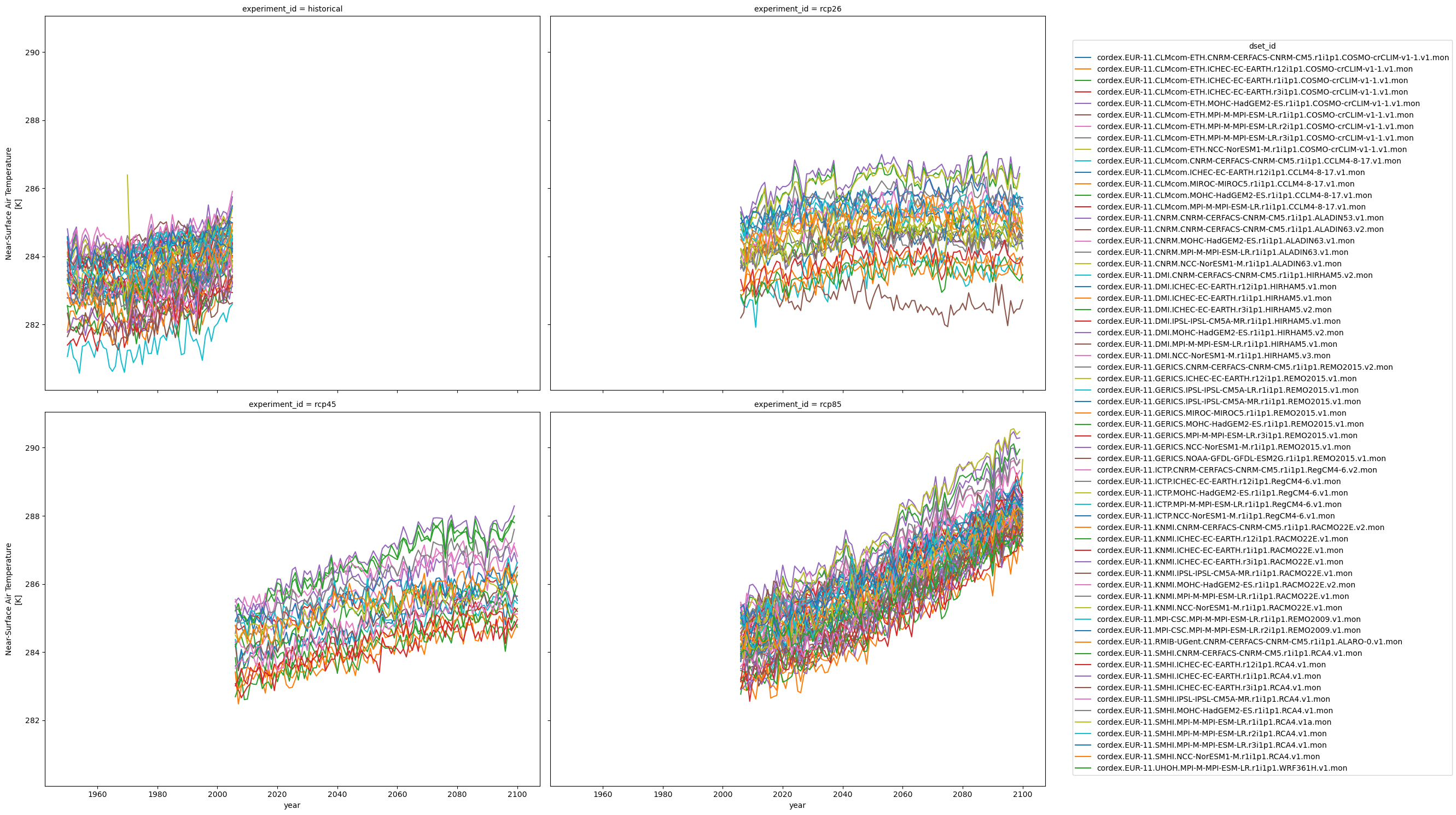
ensemble.plot(hue="experiment_id", col="dset_id", col_wrap=8)
<xarray.plot.facetgrid.FacetGrid at 0x7ffa991e7e20>
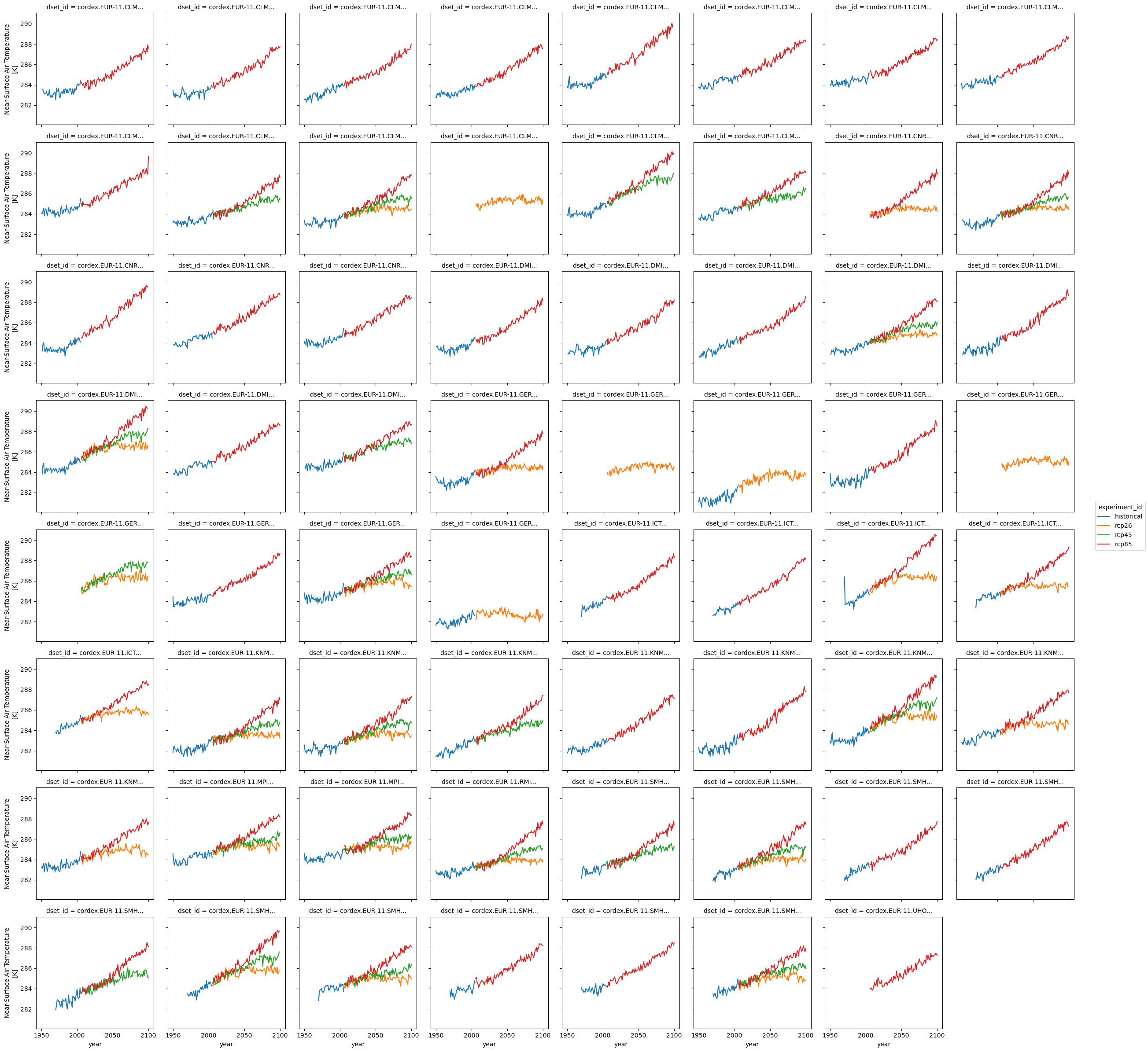
Use seaborn for statistical plots#
These plots are nice but don’t really give some valuable statistical insight. However, we can easily convert our dataset to a pandas dataframe and use, e.g., seaborn for stastical plots:
df = ensemble.to_dataframe().reset_index()
df
| experiment_id | dset_id | year | height | tas | |
|---|---|---|---|---|---|
| 0 | historical | cordex.EUR-11.CLMcom-ETH.CNRM-CERFACS-CNRM-CM5... | 1950 | 2.0 | NaN |
| 1 | historical | cordex.EUR-11.CLMcom-ETH.CNRM-CERFACS-CNRM-CM5... | 1951 | 2.0 | 283.503998 |
| 2 | historical | cordex.EUR-11.CLMcom-ETH.CNRM-CERFACS-CNRM-CM5... | 1952 | 2.0 | 283.518219 |
| 3 | historical | cordex.EUR-11.CLMcom-ETH.CNRM-CERFACS-CNRM-CM5... | 1953 | 2.0 | 283.295319 |
| 4 | historical | cordex.EUR-11.CLMcom-ETH.CNRM-CERFACS-CNRM-CM5... | 1954 | 2.0 | 283.110107 |
| ... | ... | ... | ... | ... | ... |
| 38047 | rcp85 | cordex.EUR-11.UHOH.MPI-M-MPI-ESM-LR.r1i1p1.WRF... | 2096 | 2.0 | 287.308136 |
| 38048 | rcp85 | cordex.EUR-11.UHOH.MPI-M-MPI-ESM-LR.r1i1p1.WRF... | 2097 | 2.0 | 287.299774 |
| 38049 | rcp85 | cordex.EUR-11.UHOH.MPI-M-MPI-ESM-LR.r1i1p1.WRF... | 2098 | 2.0 | 287.437317 |
| 38050 | rcp85 | cordex.EUR-11.UHOH.MPI-M-MPI-ESM-LR.r1i1p1.WRF... | 2099 | 2.0 | 287.403107 |
| 38051 | rcp85 | cordex.EUR-11.UHOH.MPI-M-MPI-ESM-LR.r1i1p1.WRF... | 2100 | 2.0 | 287.262115 |
38052 rows × 5 columns
import seaborn as sns
palette = {"historical": "C0", "rcp26": "C2", "rcp45": "C1", "rcp85": "C3"}
g = sns.relplot(
data=df[(df["year"] >= 1950) & (df["year"] <= 2098)],
x="year",
y="tas",
hue="experiment_id",
kind="line",
errorbar=("ci", 95),
aspect=2,
palette=palette,
)
g.set(title="Yearly model mean with 95th percentile confidence interval")
<seaborn.axisgrid.FacetGrid at 0x7ffa9a14d280>
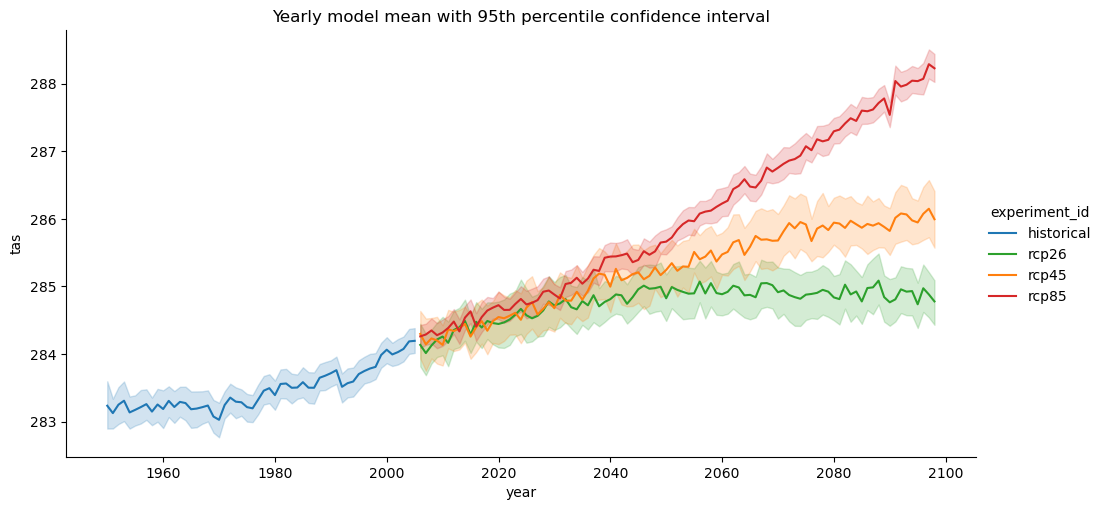
Compute the change in the rolling yearly mean#
Ususally, it’s easier to look at at rolling mean with a window size of a climate timescale, e.g., a decade. We can achieve this but we have to take care to fill the scenario datasets with historical data so that we don’t get a ‘gap’ in the data when computing the rolling mean. We can achive this by using xarrays index notation similar to pandas:
def rolling_mean(ensemble, n):
"""compute a rolling mean
Take care to fill scenario timelines with historical data.
"""
year = slice(2005 - n + 1, 2005)
ensemble.loc[dict(experiment_id=["rcp26", "rcp45", "rcp85"], year=year)] = (
ensemble.sel(experiment_id="historical").sel(year=year)
)
return ensemble.rolling(year=n, center=False).mean()
mean = rolling_mean(ensemble, 10)
Instead of looking at absolute values, it’s more interesting to look at the change in temperature with respect to a reference period. Here we choose a reference period from 1961-1990 from the historical runs.
mean = mean - mean.sel(experiment_id="historical", year=slice(1961, 1990)).mean("year")
mean
<xarray.DataArray 'tas' (experiment_id: 4, dset_id: 63, year: 151)>
array([[[ nan, nan, nan, ..., nan, nan,
nan],
[ nan, nan, nan, ..., nan, nan,
nan],
[ nan, nan, nan, ..., nan, nan,
nan],
...,
[ nan, nan, nan, ..., nan, nan,
nan],
[ nan, nan, nan, ..., nan, nan,
nan],
[ nan, nan, nan, ..., nan, nan,
nan]],
[[ nan, nan, nan, ..., nan, nan,
nan],
[ nan, nan, nan, ..., nan, nan,
nan],
[ nan, nan, nan, ..., nan, nan,
nan],
...
[ nan, nan, nan, ..., nan, nan,
nan],
[ nan, nan, nan, ..., 2.580017 , 2.627594 ,
2.588501 ],
[ nan, nan, nan, ..., nan, nan,
nan]],
[[ nan, nan, nan, ..., 3.993927 , 4.091522 ,
4.2050476],
[ nan, nan, nan, ..., 4.4456177, 4.4381714,
4.487091 ],
[ nan, nan, nan, ..., 4.3269653, 4.3974915,
4.467041 ],
...,
[ nan, nan, nan, ..., 4.248413 , 4.331543 ,
4.4112244],
[ nan, nan, nan, ..., 4.158966 , 4.149475 ,
4.22229 ],
[ nan, nan, nan, ..., nan, nan,
nan]]], dtype=float32)
Coordinates:
* year (year) int64 1950 1951 1952 1953 1954 ... 2097 2098 2099 2100
* dset_id (dset_id) <U78 'cordex.EUR-11.CLMcom-ETH.CNRM-CERFACS-CNRM...
height float64 2.0
* experiment_id (experiment_id) <U10 'historical' 'rcp26' 'rcp45' 'rcp85'
Attributes:
cell_methods: time: mean
grid_mapping: Lambert_Conformal
interval_operation: 450 s
interval_write: 1 month
long_name: Near-Surface Air Temperature
online_operation: average
standard_name: air_temperature
units: KAgain we will convert the data to a dataframe and use seaborn for a statistical plot.
df = mean.to_dataframe().reset_index()
df
| experiment_id | dset_id | year | height | tas | |
|---|---|---|---|---|---|
| 0 | historical | cordex.EUR-11.CLMcom-ETH.CNRM-CERFACS-CNRM-CM5... | 1950 | 2.0 | NaN |
| 1 | historical | cordex.EUR-11.CLMcom-ETH.CNRM-CERFACS-CNRM-CM5... | 1951 | 2.0 | NaN |
| 2 | historical | cordex.EUR-11.CLMcom-ETH.CNRM-CERFACS-CNRM-CM5... | 1952 | 2.0 | NaN |
| 3 | historical | cordex.EUR-11.CLMcom-ETH.CNRM-CERFACS-CNRM-CM5... | 1953 | 2.0 | NaN |
| 4 | historical | cordex.EUR-11.CLMcom-ETH.CNRM-CERFACS-CNRM-CM5... | 1954 | 2.0 | NaN |
| ... | ... | ... | ... | ... | ... |
| 38047 | rcp85 | cordex.EUR-11.UHOH.MPI-M-MPI-ESM-LR.r1i1p1.WRF... | 2096 | 2.0 | NaN |
| 38048 | rcp85 | cordex.EUR-11.UHOH.MPI-M-MPI-ESM-LR.r1i1p1.WRF... | 2097 | 2.0 | NaN |
| 38049 | rcp85 | cordex.EUR-11.UHOH.MPI-M-MPI-ESM-LR.r1i1p1.WRF... | 2098 | 2.0 | NaN |
| 38050 | rcp85 | cordex.EUR-11.UHOH.MPI-M-MPI-ESM-LR.r1i1p1.WRF... | 2099 | 2.0 | NaN |
| 38051 | rcp85 | cordex.EUR-11.UHOH.MPI-M-MPI-ESM-LR.r1i1p1.WRF... | 2100 | 2.0 | NaN |
38052 rows × 5 columns
import seaborn as sns
palette = {"historical": "C0", "rcp26": "C2", "rcp45": "C1", "rcp85": "C3"}
g = sns.relplot(
data=df[(df["year"] >= 1950) & (df["year"] <= 2098)],
x="year",
y="tas",
hue="experiment_id",
kind="line",
errorbar=("ci", 95),
aspect=2,
palette=palette,
)
g.set(
title="Model mean of 10-year running annual mean with 95th percentile confidence interval"
)
<seaborn.axisgrid.FacetGrid at 0x7ffa796c5cd0>
